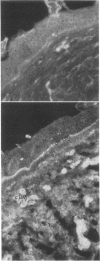Abstract
Diabetic connective tissues exhibit a deranged regulation of extracellular matrix biosynthesis. Fibronectin is shown to be increased in human dermal connective tissue by immunofluorescence, mainly at the dermoepidermal and capillary basement membranes. The rate of fibronectin biosynthesis, excretion, and incorporation in a pericellular polymeric form was investigated using genetically diabetic KK mouse skin and fibroblasts as compared to Swiss and C57BL mouse skin and fibroblasts. The rate of incorporation of [35S]methionine into proteins recovered in the culture medium or in deoxycholate and NaDodSO4 or urea extracts was investigated. The rate of incorporation in the medium and deoxycholate extracts was comparable. However, the relative rate of incorporation of the tracer in the NaDodSO4-extractable, pericellular polymeric form was increased in the diabetic KK fibroblasts both for total proteins and for fibronectin. In pulse-chase experiments, the deoxycholate-soluble and NaDodSO4-soluble fractions exhibited a precursor-product relationship. The rate of passage of fibronectin from the deoxycholate-soluble (cellular compartment) form to the NaDodSO4-soluble (pericellular polymeric) form was strongly accelerated in the diabetic fibroblast cultures. These results confirm the increased rate of synthesis of fibronectin in diabetic fibroblasts as well as its processing from the cellular compartment to the polymeric pericellular form. The increase of fibronectin in diabetic connective tissues, in the matrix as well as in the basement membranes, may play a role in the mechanism of micro- and macroangiopathies and in the perturbed permeability characteristics of the diabetic capillaries, and as a glycoprotein it may contribute to the increased periodic acid/Schiff reagent staining of diabetic capillary basement membranes.
Full text
PDF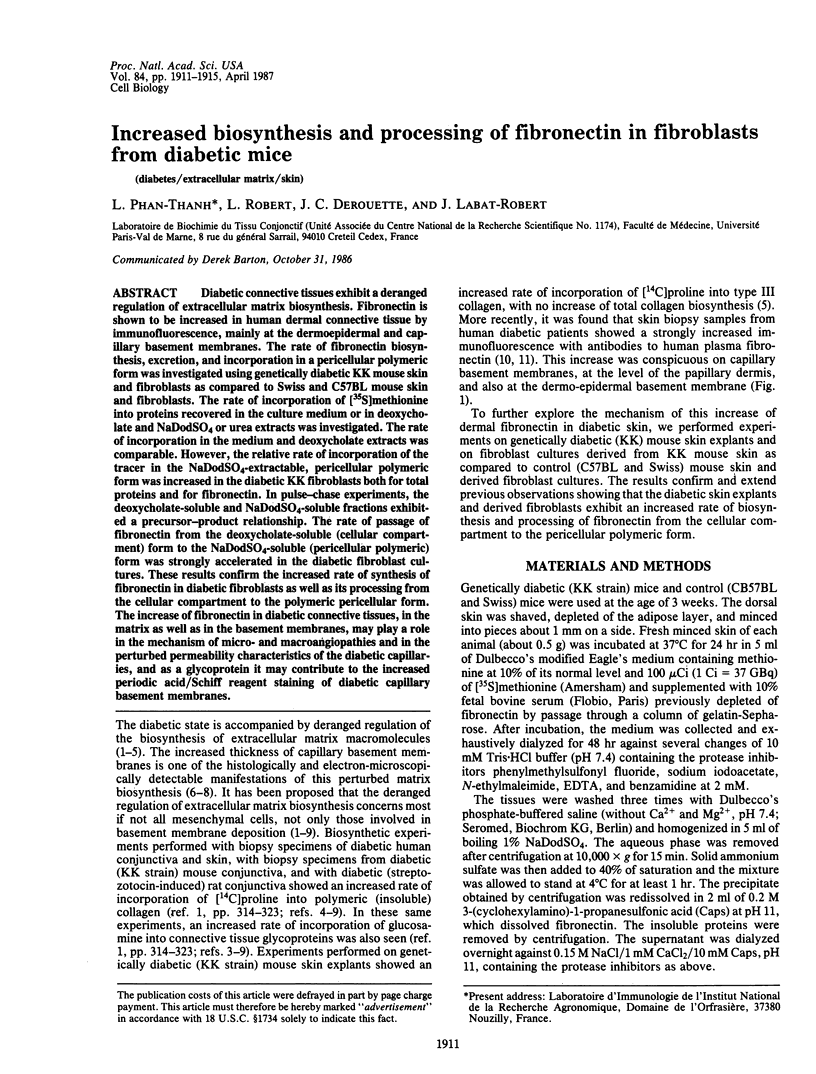
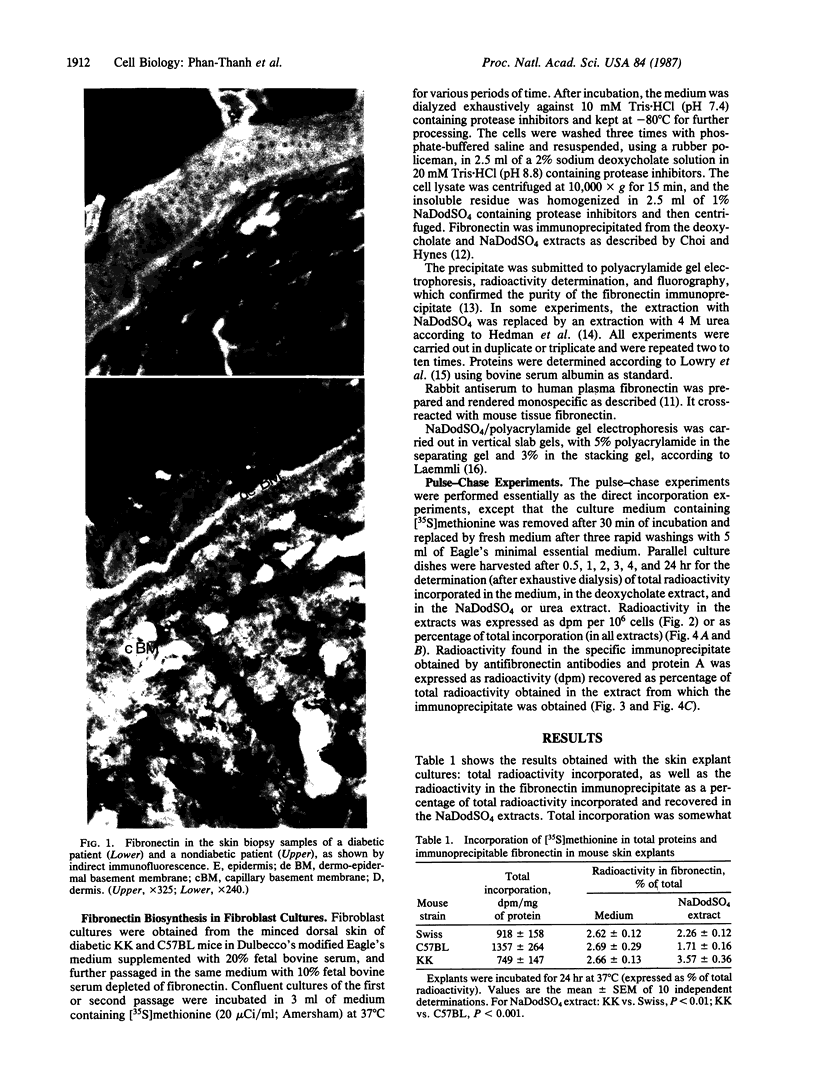
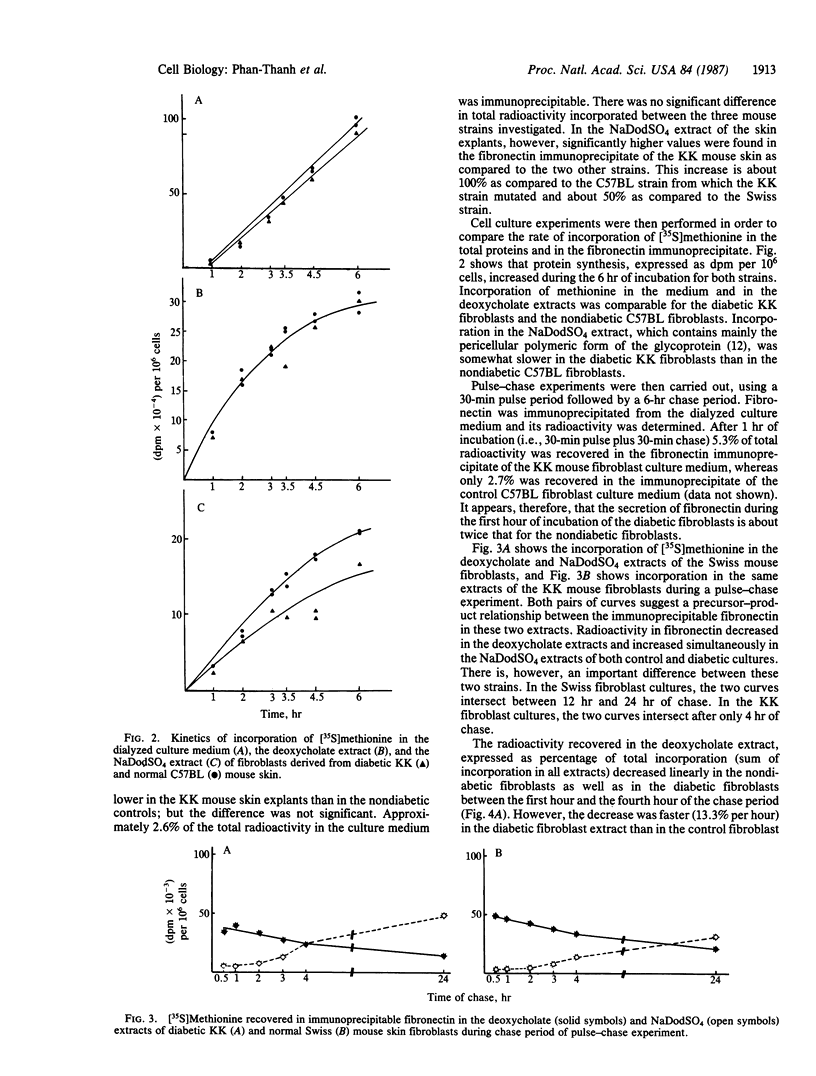
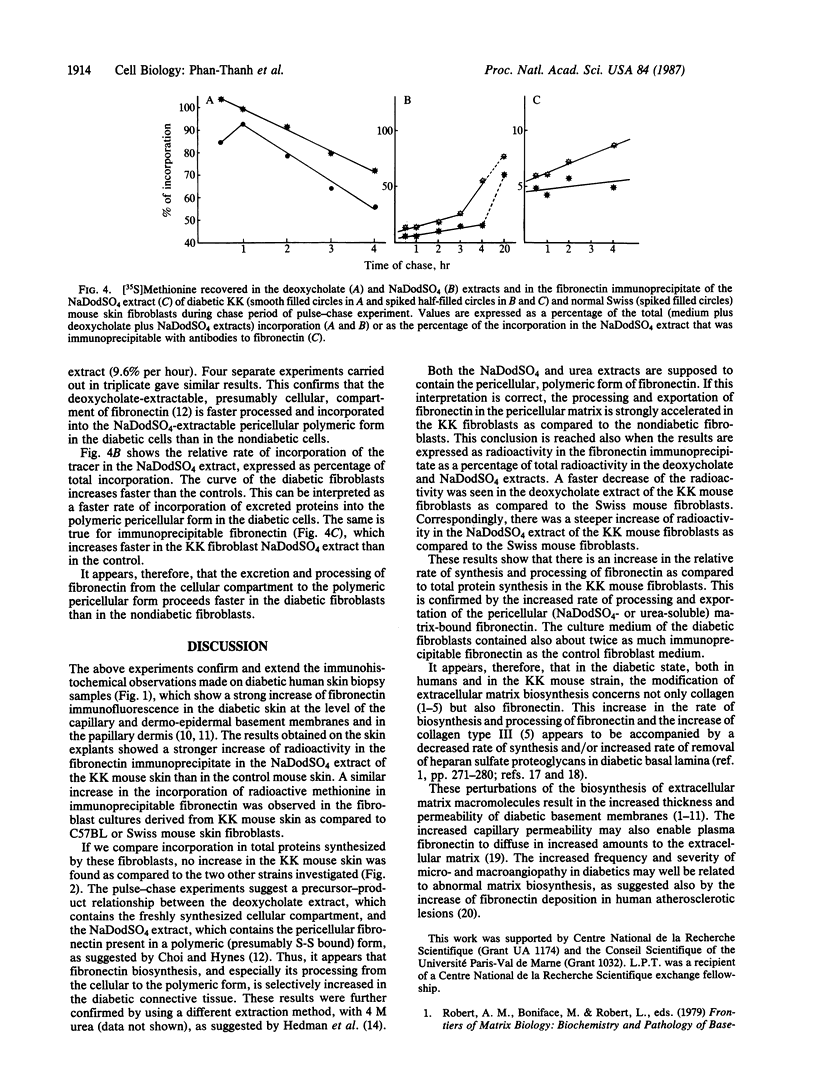
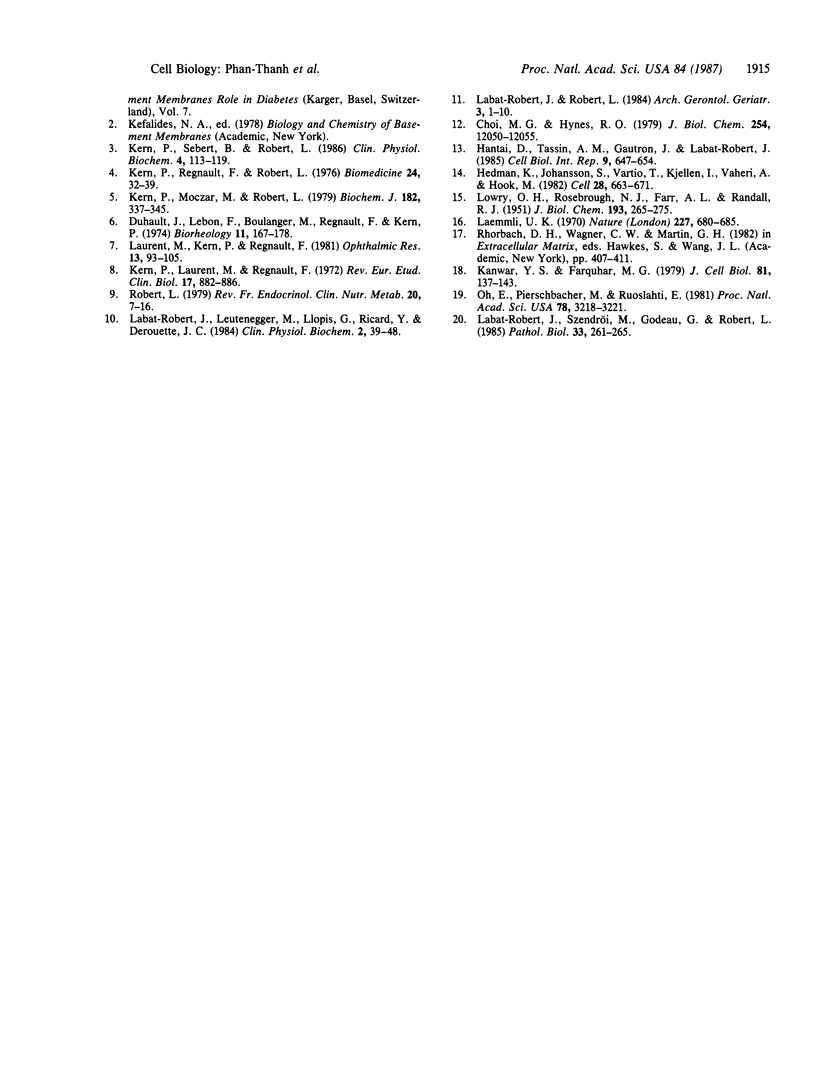
Images in this article
Selected References
These references are in PubMed. This may not be the complete list of references from this article.
- Choi M. G., Hynes R. O. Biosynthesis and processing of fibronectin in NIL.8 hamster cells. J Biol Chem. 1979 Dec 10;254(23):12050–12055. [PubMed] [Google Scholar]
- Duhalult J., Lebon F., Boulanger M., Regnault F., Kern F. Microangiopathie diabetique: etude comparative chez l'homme et l'animal. Biorheology. 1974 Jun;11(3):167–178. [PubMed] [Google Scholar]
- Hantaï D., Tassin A. M., Gautron J., Labat-Robert J. Biosynthesis of laminin and fibronectin by rat satellite cells during myogenesis in vitro. Cell Biol Int Rep. 1985 Jul;9(7):647–654. doi: 10.1016/0309-1651(85)90057-8. [DOI] [PubMed] [Google Scholar]
- Hedman K., Johansson S., Vartio T., Kjellén L., Vaheri A., Hök M. Structure of the pericellular matrix: association of heparan and chondroitin sulfates with fibronectin-procollagen fibers. Cell. 1982 Mar;28(3):663–671. doi: 10.1016/0092-8674(82)90221-5. [DOI] [PubMed] [Google Scholar]
- Kanwar Y. S., Farquhar M. G. Anionic sites in the glomerular basement membrane. In vivo and in vitro localization to the laminae rarae by cationic probes. J Cell Biol. 1979 Apr;81(1):137–153. doi: 10.1083/jcb.81.1.137. [DOI] [PMC free article] [PubMed] [Google Scholar]
- Kern P., Laurent M., Regnault F. Biochemical and ultrastructural studies of conjunctiva of hereditary diabetic mice. Rev Eur Etud Clin Biol. 1972 Nov;17(9):882–886. [PubMed] [Google Scholar]
- Kern P., Moczar M., Robert L. Biosynthesis of skin collagens in normal and diabetic mice. Biochem J. 1979 Aug 15;182(2):337–345. doi: 10.1042/bj1820337. [DOI] [PMC free article] [PubMed] [Google Scholar]
- Kern P., Regnault F., Robert L. Biochemical and ultrastructural study of human diabetic conjunctiva. Biomedicine. 1976 Jan;24(1):32–39. [PubMed] [Google Scholar]
- Kern P., Sebert B., Robert L. Increased type-III/type-I collagen ratios in diabetic human conjunctival biopsies. Clin Physiol Biochem. 1986;4(2):113–119. [PubMed] [Google Scholar]
- LOWRY O. H., ROSEBROUGH N. J., FARR A. L., RANDALL R. J. Protein measurement with the Folin phenol reagent. J Biol Chem. 1951 Nov;193(1):265–275. [PubMed] [Google Scholar]
- Labat-Robert J., Leutenegger M., Llopis G., Ricard Y., Derouette J. C. Plasma and tissue fibronectin in diabetes. Clin Physiol Biochem. 1984;2(1):39–48. [PubMed] [Google Scholar]
- Labat-Robert J., Robert L. Modifications of fibronectin in age-related diseases: diabetes and cancer. Arch Gerontol Geriatr. 1984 May;3(1):1–10. doi: 10.1016/0167-4943(84)90011-6. [DOI] [PubMed] [Google Scholar]
- Labat-Robert J., Szendroi M., Godeau G., Robert L. Comparative distribution patterns of type I and III collagens and fibronectin in human arteriosclerotic aorta. Pathol Biol (Paris) 1985 Apr;33(4):261–265. [PubMed] [Google Scholar]
- Laemmli U. K. Cleavage of structural proteins during the assembly of the head of bacteriophage T4. Nature. 1970 Aug 15;227(5259):680–685. doi: 10.1038/227680a0. [DOI] [PubMed] [Google Scholar]
- Oh E., Pierschbacher M., Ruoslahti E. Deposition of plasma fibronectin in tissues. Proc Natl Acad Sci U S A. 1981 May;78(5):3218–3221. doi: 10.1073/pnas.78.5.3218. [DOI] [PMC free article] [PubMed] [Google Scholar]



